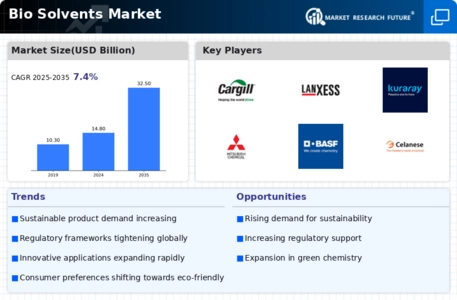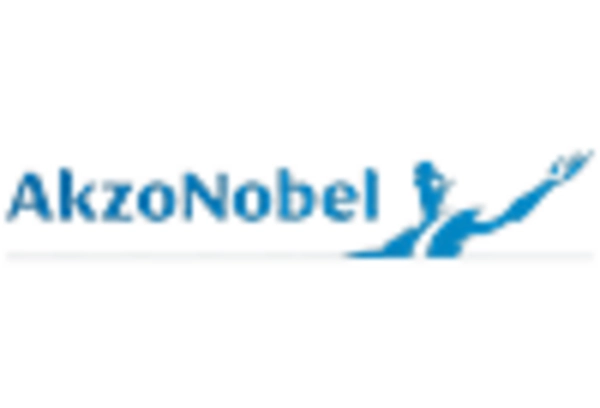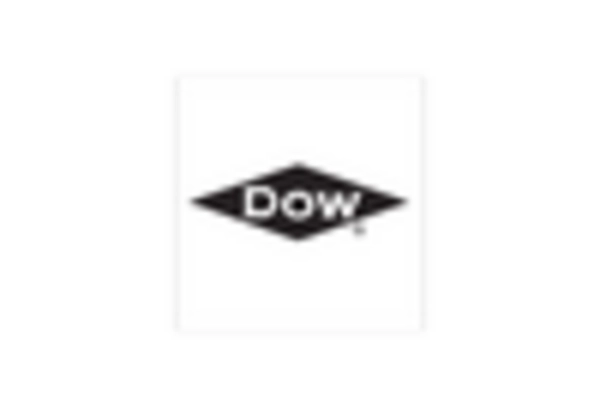Regulatory Frameworks
Regulatory frameworks play a crucial role in shaping the Bio Solvents Market. Governments worldwide are implementing stringent regulations aimed at reducing volatile organic compounds (VOCs) in industrial applications. These regulations encourage manufacturers to transition from conventional solvents to bio-based alternatives, which are often less harmful to human health and the environment. For instance, the European Union's REACH regulation has prompted many companies to reformulate their products using bio solvents. This regulatory push is expected to drive the market, as compliance becomes increasingly necessary for market access. The Bio Solvents Market is likely to see a surge in demand as businesses seek to adhere to these regulations while maintaining product performance and safety standards.
Technological Innovations
Technological innovations are significantly influencing the Bio Solvents Market. Advances in extraction and production technologies have enhanced the efficiency and cost-effectiveness of bio solvent manufacturing. For example, the development of new fermentation processes has improved the yield of bio-based solvents, making them more competitive with traditional petrochemical solvents. This technological progress is expected to expand the range of applications for bio solvents, particularly in sectors such as pharmaceuticals and personal care products. The Bio Solvents Market is likely to benefit from these innovations, as they not only lower production costs but also improve the overall quality of bio solvents. As technology continues to evolve, it may open new avenues for growth and diversification within the market.
Sustainability Initiatives
The increasing emphasis on sustainability appears to be a primary driver for the Bio Solvents Market. As industries strive to reduce their carbon footprints, bio solvents, derived from renewable resources, are gaining traction. This shift is evident in sectors such as paints, coatings, and adhesives, where traditional solvents are being replaced by bio-based alternatives. The market for bio solvents is projected to grow at a compound annual growth rate of approximately 5.5% from 2023 to 2030, indicating a robust demand for sustainable solutions. Companies are increasingly adopting bio solvents to align with environmental regulations and consumer preferences, which further propels the Bio Solvents Market. This trend suggests a long-term commitment to eco-friendly practices, potentially reshaping the landscape of various manufacturing processes.
Consumer Awareness and Demand
Consumer awareness regarding environmental issues is driving demand within the Bio Solvents Market. As consumers become more informed about the impact of chemical solvents on health and the environment, there is a growing preference for products that utilize bio-based solvents. This shift in consumer behavior is particularly evident in the cosmetics and cleaning products sectors, where brands are increasingly marketing their use of eco-friendly ingredients. The Bio Solvents Market is responding to this demand by expanding product lines that feature bio solvents, thereby appealing to environmentally conscious consumers. Market Research Future indicates that products labeled as 'green' or 'eco-friendly' are experiencing higher sales growth, suggesting that consumer preferences are likely to continue influencing market dynamics.
Economic Factors and Market Growth
Economic factors are also pivotal in shaping the Bio Solvents Market. The increasing cost of petroleum-based solvents, coupled with fluctuating oil prices, has prompted manufacturers to explore more stable and sustainable alternatives. Bio solvents, often derived from agricultural feedstocks, can provide a more predictable pricing structure, which is appealing to businesses looking to mitigate risks associated with volatile oil markets. Furthermore, the Bio Solvents Market is expected to benefit from the rising demand for bio-based products across various sectors, including automotive and construction. As economies continue to prioritize sustainability and resource efficiency, the market for bio solvents is likely to expand, driven by both economic incentives and environmental considerations.


















Leave a Comment